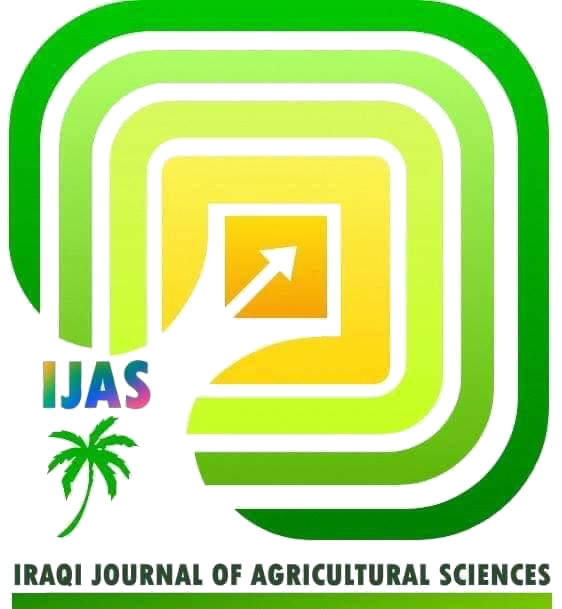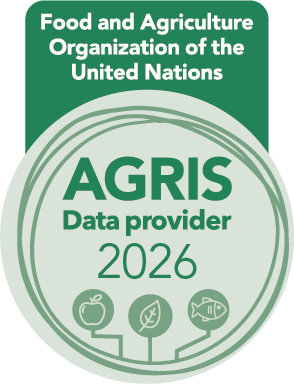INTESTINAL HISTOPATHOLOGICAL STUDY, ISOLATION AND MOLECULAR DETECTION OF CLOSTERDIUM PERFERNGES, FROM LAYER CHICKEN IN BASRAH GOVERNORATE
DOI:
https://doi.org/10.36103/2rwa8v79Keywords:
Necrotic enteritis, toxins.Abstract
This study was designed for the isolation and molecular identification of Clostridium perfringens. From a total of 200 samples, C. perfringens was isolated from 30 samples (25%) of laying hens and confirmed using a PCR assay by amplifying a segment of a gene (16S rDNA gene) from C. perfringens. The result of histopathology study showed severe necrotic area surrounded by inflammatory cells, erosions of the intestinal epithelium, ulceration of the epithelium, villous necrosis finding surrounded by inflammatory cells, vascular congestion, goblet cell hyperplasia. For the type of toxin, the bacterial isolates were analyzed by PCR using specific primers in order to determine the presence of cpa genes (cpb, iA, cpe, cpb2). Among the 30 C. perfringens isolates, 10 isolates were identified (33.33%) with C. She is type A (carrying the alpha toxin gene). Of these 10 isolates, 5 isolates (50%) were identified as type A simplex and 5 (50%) were identified as heterozygous but no None of the isolates carry both cpb2 and cpe genes. As the dominant species, 20 isolates (66.66%) were identified as C. The research concluded that C. perfringens was one of the most important isolates from laying hens, and the toxin type A was identified as heterozygous (carrying cpb2), and type C is the most prevalent toxin in Basrah, and the detected toxins cause pathological changes in the intestine.
References
1.Abdelrahim A.M., N. Radomski, S. Delannoy, S. Djellal, M. Le Négrate, K. Hadjab, P. Fach, J. Hennekinne, M. Mistou and O. Firmesse. 2019. Large-scale genomic analyses and toxinotyping of Clostridium perfringens implicated in foodborne outbreaks in France. Front. Microbiol.;10:777. https://doi.org/10.3389/fmicb.2019.00777
2.Adhikari. R. and R. Jha. 2020. An approach to alternative strategies to control avian coccidiosis and necrotic enteritis. J. App. Poult. Res., 29(2): 515-534. https://doi.org/10.1016/j.japr.2019.11.005
3.Afshari, A., A. Jamshidi, J. Razmyar and M. Rad. 2015. Genotyping of Clostridium perfringens isolated from broiler meat in northeastern of Iran. Vet. Res. Form. 6(4): 279-284. https://vrf.iranjournals.ir/article_14940_ca09f11dda2903bf1003848b42bcc9f8.pdf
4.Ahsani, M.R., M.S. Bafti, A.K. Esmailizadeh, and M. R. Mohammad. 2011. Genotyping of isolates of Clostridium perfringens from vaccinated and unvaccinated sheep. Small Rumin. Res., 95(1): 65-69. https://doi.org/10.1016/j.smallrumres.2010.09.001
5.Al-haideri, A. Q., J. Y. Mustafa and H. M. Al-Tameem. 2025. Detection of Clostridium perfringens in uncooked meat and butchers' tools in Basrah: A public health concern Basrah J. Vet. Res., 24(2),14-24. https://doi.org/10.23975/bjvr.2025.157631.1201
6.Al-haideri, A. Q., J. Y. Mustafa and H. M. Al-Tameem. 2025. Dominance of Clostridium perfringens toxin type A and enterotoxemia cases among Basrah governorate sheep. Assiut Vet. Med. J, 71 (185) No. 185, 344-354. https://doi.org/10.21608/avmj.2025.347440.1535
7.Al-Sheikly, F. and R. B. Truscott. 1976. The pathology of necrotic enteritis of chickens following infusion of broth cultures of Clostridium perfringens into the duodenum. Avian Diseases. 21: 230-240. https://doi.org/10.2307/1589344
8.Baums, C. G., U. Schotte, G. Amtsberg and R. Goethe. 2004. Diagnostic multiplex PCR for toxin genotyping of Clostridium perfringens isolates. Vet. Microbiol., 100, 11-16.
https://doi.org/10.1016/S0378-1135(03)00126-3
9.Brynestad, S. and P. E. Granum. 2002. Clostridium perfringens and food borne infections. Int. J. Food Microbiol., 74: 195-202.
https://doi.org/10.1016/s0168-1605(01)00680-8
10.Bueschel, D. M., B. H. Jost. and S. J. Billington. 2003. Prevalence of cpb2, encoding beta2 toxin, in Clostridium perfringens field isolates: Correlation of genotype with phenotype. Vet. Microbiol. 94: 121-129.
https://doi.org/10.1016/s0378-1135(03)00081-6
11.Cappuccino, J. G. and C. Welsh. 2018. Microbiology: A laboratory manual (11th ed.). Global Edition. Pearson Education Limited.
12.Craven, S.E. N.A. Cox, J.S. Bailey and D.E. Cosby. 2003. Incidence and tracking of Clostridium perfringens through an integrated broiler chicken operation. Avian Dis., 47(3):707-11
13.Erol, I., M. Goncuoglu, N. D. Ayaz, F. S. Bilir Ormanci and G. Hildebrandt. 2008. Molecular typing of Clostridium perfringens isolated from turkey meat by multiplex PCR. Appl. Microbiol., 47 (1), 31-34.
https://doi.org/10.1111/j.1472-765X.2008.02379.x
14.Freedman, J.C., J.R. Theoret, J. A. Wisniewski, F.A. Uzal, J. I. Rood and B.A. McClane. 2015. Clostridium perfringens type A–E toxin plasmids. Res. Microbiol., 166(4), 264-279.
https://doi.org/10.1016/j.resmic.2014.09.004
15.Ghaleb, L., W. AL-Wassouf, D. M. Jwher and I. Horani. 2025. Microbiological and histopathological study of enterotoxaemia caused by Clostridium perfringens in Syrian lambs. J. Appl. Vet. Sci., 10(1), 1-9. https://dx.doi.org/10.21608/javs.2024.322305.1422
16.Grenda, T., A. Jarosz, M. Sapała, A. Grenda, E. Patyra and K. Kwiatek. 2023. Clostridium perfringens - Opportunistic foodborne pathogen, its diversity and epidemiological significance. Pathogens, 12(6), 768. https://doi.org/10.3390/pathogens12060768
17.Guran, H.S. and G. Oksuztepe. 2013. Detection and typing of Clostridium perfringens from retail chicken meat parts. Lett. Appl. Microbiol. 57(1): 77-82.
https://doi.org/10.1111/lam.12088
18.Heikinheimo, A. and H. Korkeala. 2005. Multiplex PCR assay for toxinotyping Clostridium perfringens isolates obtained from Finnish broiler chickens. Appl. Microbiol., 40 (6), 407-411.
https://doi.org/10.1111/j.1472-765X.2005.01702.x
19.Heikinheimo, A., M. Lindström, P.E. Granum and H. Korkeala. 2006. Humans as reservoir for enterotoxin gene–carrying Clostridium perfringens type A. Emerg. Infect. Dis., 12(11), 1724. https://doi.org/10.3201/eid1211.060478
20.Hibberd M. C, A. P. Neumann, T.G. Rehberger, and G.R. Siragusa. 2011. Multilocus sequence typing subtypes of poultry Clostridium perfringens isolates demonstrate disease niche partitioning. J. Clin. Microbiol., 49(4):1556–1567. https://doi.org/10.1128/JCM.01884-10
21.Hussein, E.O.S., S. H. Ahmed and A. M. Abudabos. 2020. Effect of antibiotic, phytobiotic and probiotic supplementation on growth, blood indices and intestine health in broiler chicks challenged with Clostridium perfringens, Animals. 10(3), 507.
https://doi.org/10.3390/ani10030507
22.Immerseel, F.V. J. De Buck, F. Pasmans, G. Huyghebaert, F. Haesebrouck and R. Ducatelle. 2010. Clostridium perfringens in poultry: an emerging threat for animal and public health. Avian Pathol., 33:(6) 537-549.
https://doi.org/10.1080/03079450400013162
23.Jaber, N. N., N. S. Hadi, A. L. Mohammed, M. Idan and A. Niama. 2021. Vitik detection of aerobic spore-forming bacteria isolated from raw milk, skim milk powder and UHT milk. Medico-legal Update, 21(1), 679. https://doi.org/10.37506/mlu.v21i1.2390
24.Kalender, H. and H.B. Ertas. 2005. Isolation of Clostridium perfringens from chickens and detection of the alpha toxin gene by polymerase chain reaction (PCR). Cited by Al-haideri, A. Q., J. Y. Mustafa and H. M. Al-Tameem. 2025. Dominance of Clostridium perfringens toxin type A and enterotoxemia cases among Basrah governorate sheep. Assiut Vet. Med. J, 71 (185), 344-354. https://doi.org/10.21608/avmj.2025.347440.1535
25.Keyburn, A.L., X.X. Yan, T.L. Bannam, F. VanImmerseel, J.I. Rood and R.J. Moore. 2010. Association between avian necrotic enteritis and Clostridium perfringens strains expressing NetB toxin. Vet. Res. 41(2),21-29.
https://doi.org/10.1051/vetres/2009069
26.Lin, Y.T. and R. Labbe 2003. Enterotoxigenicity and genetic relatedness of Clostridium perfringens isolates from retail foods in the United States. Appl. Environ. Microbiol. 69, 1642-1646. https://doi.org/10.1128/AEM.69.3.1642-1646.2003
27.Lovland, A. and M. Kaldhusdal. 2001. Severely impaired production performance in broiler flocks with high incidence of Clostridium perfringens-associated hepatitis. Avian Pathol. 30, 73-81. https://doi.org/10.1080/03079450020023230
28.Mahmood, S.S. 2022. The prevalence of Blandm, blavim genes among Enterobacter cloacae bacteria. Iraqi J. Agric. Sci., 53(4), 958- 964.
https://doi.org/10.36103/ijas.v53i4.1608
29.Meer, R. and J. G. Songer. 1997. Multiplex polymerase chain reaction assay for genotyping Clostridium perfringens. Am. J. Vet. Res. 58: 702-705. https://pubmed.ncbi.nlm.nih.gov/9215442/
30.Miyamoto, K., J. Li and B.A. Mc Clane. 2012. Enterotoxigenic Clostridium perfringens: detection and identification. Microbes Environ. 27: 343-349. https://doi.org/10.1264/jsme2.me12002
31.Moore, R. J. 2016. Necrotic enteritis predisposing factors in broiler chickens. Avian Pathol. 45(3):275–281. https://doi.org/10.1080/03079457.2016.1150587
32.Narayan, K.G., D.K. Sinha and D.K. Singh. 2023. Clostridium perfringens. In: Veterinary Public Health and Epidemiology. Springer, Singapore. https://doi.org/10.1007/978-981-19-7800-5_34
33.Piatti, R.M., A.A. Ikuno and L. Baldassi. 2004. Detection of bovine Clostridium perfringens by polymerase chain reaction. J. Venom. Anim. Toxins. Incl. Trop. Dis. 10(2): 154-160.
https://doi.org/10.1590/S1678-91992004000200005
34.Shrestha, A., F.A. Uzal and B.A. McClane. 2018. Enterotoxic clostridia: Clostridium perfringens enteric diseases, Microbiol. Spectr., 6(5): 6-15. https://doi.org/10.1128/microbiolspec.GPP3-0003-2017
35.Prescott, JF., JA. Smyth, B. Shojadoost and A Vince. 2016. Experimental reproduction of necrotic enteritis in chickens: a review. Avian Pathol. 45(3):317-22.
https://doi.org/10.1080/03079457.2016.1141345
36.Songer, J.G. and R.R. Meer. 1996. Genotyping of Clostridium perfringens by polymerase chain reaction is a useful adjunct to diagnosis of clostridial enteric disease in animals. Anaerobe. 2: 197-203. https://doi.org/10.1006/anae.1996.0027
37.Timbermont, L., F. Haesebrouck, R. Ducatelle and F. Van Immerseel. 2011. Necrotic enteritis in broilers: an updated review on the pathogenesis. Avian Pathol., 40(4), 431-437.
https://doi.org/10.1080/03079457.2011.590967
38.Van Immerseel, F., J. De Buck and F. Pasmans. 2004. Clostridium perfringens in poultry: An emerging threat for animal and public health. Avian Pathol. 33, 537-549. https://doi.org/10.1080/03079450400013162
39. Wu, J., W. Zhang and B. Xie. 2009. Detection and toxin typing of Clostridium perfringens in formalin-fixed, paraffin embedded tissue samples by PCR. J. Clin. Microbiol. 47, 807-810. https://doi.org/10.1128/JCM.01324-08
40.Yang, WY., YJ. Lee, HY. Lu, SL. Branton, CH. Chou and C. Wang. 2019. The netB-positive Clostridium perfringens in the experimental induction of necrotic enteritis with or without predisposing factors. Poult Sci. 1;98(11):5297-5306. https://doi.org/10.3382/ps/pez311.
Downloads
Published
Issue
Section
License
Copyright (c) 2025 IRAQI JOURNAL OF AGRICULTURAL SCIENCES

This work is licensed under a Creative Commons Attribution-NonCommercial 4.0 International License.

2.jpg)


